National Independence Day is celebrated in November, and this year, Poland is celebrating many anniversaries. With that in mind, CR brings you a collage of significant anniversaries, some well-known, some less so; some joyful, some tragic.
1914

PHOTO: Library of Congress | The date 9/14/20 is written in reverse on the top right.
One hundred years ago, Józef Piłsudski announced the formation of the Polish Legions in Galicia – the first step towards Poland regaining independence in 1918.
Keep an eye on that mustache; it will be back in 1989.
1919
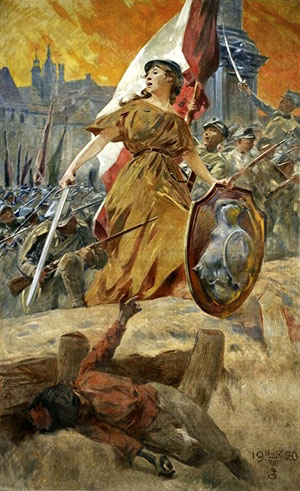
PAINTING: Zdzisław Jasiński’s “Allegory of Victory in 1920 (Forward Warsaw).” 1920.
National Museum of Warsaw
Piłsudski’s Legions face the invading Red Army and are victorious in the Battle for Warsaw in 1920, which stopped the Bolsheviks from imposing communism in western Europe.
“Not that the West was grateful,” CR author Patrice Dabrowski writes.
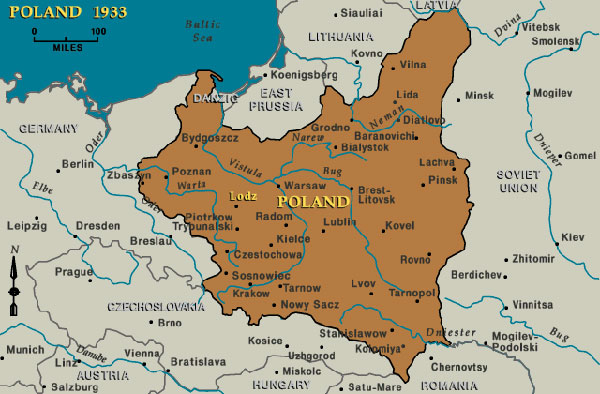
MAP: Interwar Poland, courtesy of Buffalo University’s Info-Poland
But difficult times were ahead. The newly independent state had to sort out six currencies, five regions, four languages, three legal codes, two different railway gauges and 18 political parties. And all as the world plunged into a calamitous financial depression.
1939
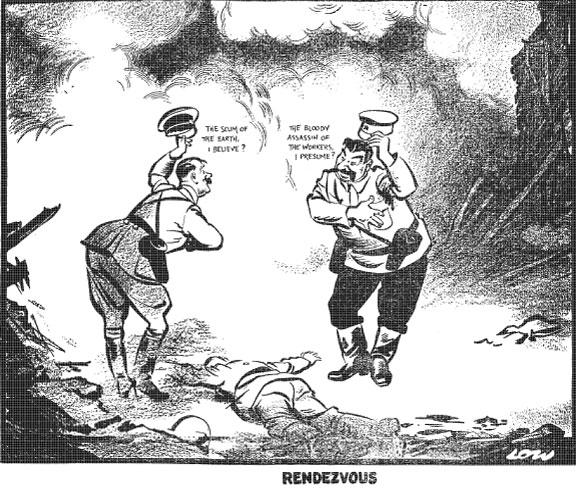
CARTOON: Published Sept. 20, 1939 in the Evening Standard, David Low’s political cartoon, titled “Rendezvous,” presents Hitler greeting Stalin upon their mutual invasion of Poland. “The scum of the earth, I believe?
Hitler asks. “The bloody assassin of the workers, I presume?” Stalin replies
The neighborhood could not have been worse.

Poland’s Enigma masterminds with a copy of the Enigma machine on display at the Museum of Technology in Warsaw.
Master hackers Marian Rejewski, Henryk Zygalski and Jerzy Różycki crack the Enigma code at the University of Poznań; in July 1939 they present their results to British and French intelligence. Not that either country showed much gratitude.

But this August the Global Institute of Electrical and Electronics Engineers helped correct that injustice with a milestone recognition:
“Polish Cypher Bureau mathematicians . . . broke the German Enigma cypher machine code. They built . . . the first cryptanalytic machine to break Enigma codes. The work was a foundation of British code breaking efforts which, with later American assistance, helped to end World War II.”
1939 – 1945: In Poland
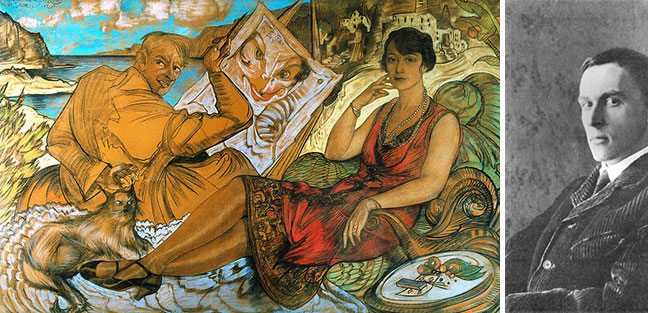
PAINTING: “The Falsity of Woman (Maryla Grosmanowa and self-portrait)” by Witkacy; 1927.
National Museum in Warsaw
Stanisław Ignacy Witkiewicz (Witkacy): surrealist painter, photographer, author, philosopher and – cultural treasure. When the Russians joined the Germans in their attack on Poland on September 17, 1939, Witkacy lost all hope, and committed suicide the next day.

PAINTING: “Meeting of a Jewish youth and two women on an urban street” by Bruno Schulz; 1920.
Adam Mickiewicz Museum of Literature in Warsaw
Bruno Schulz: writer, painter, illustrator and graphic artist. His works portrayed Jewish life in Poland with a mix of fantasy and realism, Jewish orthodoxy and European modernism. A much-loved writer, he was shot in 1942 at close range by a German officer in Drohobych, the small town where he was born.
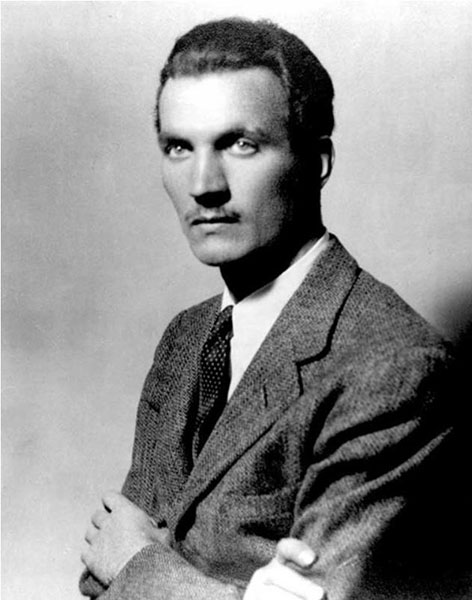
A young Jan Karski
In 1942 and 1943, Jan Karski, a Home Army courier, brought eyewitness accounts of the ongoing genocide of the Jews to Allied leaders in the West.
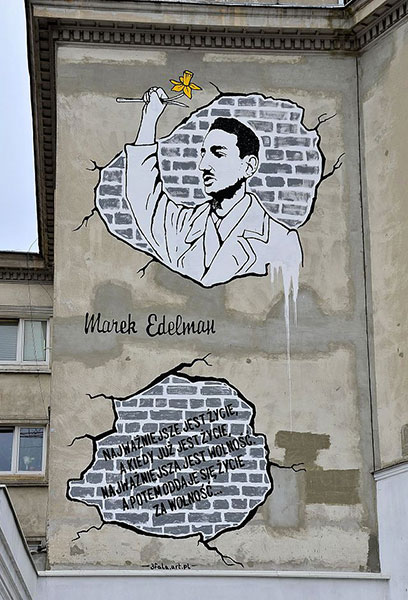
A mural of Marek Edelman on Nowolipki Street in Warsaw.
The words read, “Life is most important; and when there is life, freedom is most important. And then we give our life for freedom.”
PHOTO by Adrian Grycuk
Marek Edelman, one of the leaders of the Jewish Fighting Organization in the Warsaw Ghetto, fought in the 1943 Ghetto Uprising and then in the city-wide 1944 Warsaw Uprising. He became a noted cardiologist after the war, and took part in Poland’s Round Table Talks in 1989 as a member of Solidarity.

Żegota: The Council for Aid to Jews in Occupied Poland
Some of the founders, from left: Adolf Berman; Władysław Bartoszewski; Irena Sendler; Leon Feiner; Zofia Kossak
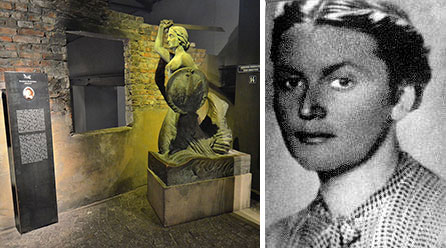
A copy of Warsaw’s iconic Syrenka monument in the Warsaw Uprising Museum, along with a tablet memorializing Krystyna Krahelska.
PHOTO by Adrian Grycuk
The Syrenka – the mermaid who symbolizes Warsaw – was designed by Ludwika Nitschowa in 1936.
Her model was Krystyna Krahelska – writer, poet, songwriter and leading Resistance figure in the Home Army. She was killed on the second day of the 1944 Warsaw Uprising.
1939 – 1945: Poles Abroad
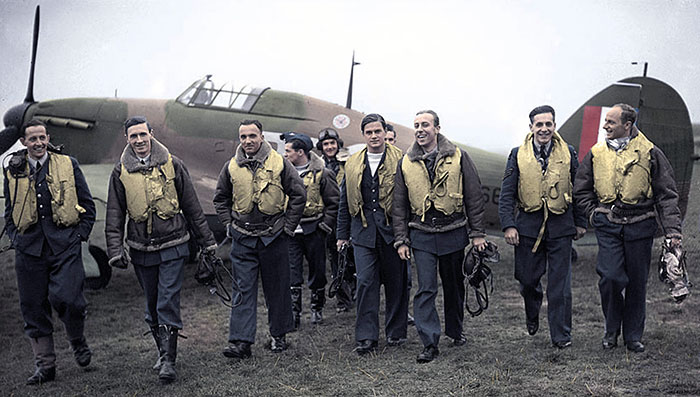
Check out that swagger! And rightly so.
The handsome 303 daredevils, left to right: F/Lt Lt Kent, F/O Grzeszczak, P/O Radomski, P/O Zumbach, P/O Łokuciewski, F/O Henneberg, Sgt Rogowski, Sgt Szaposznikow; 1940.
“Had it not been for the magnificent material contributed by the Polish squadrons and their unsurpassed gallantry, I hesitate to say that the outcome of the Battle would have been the same.”
—Air Chief Marshal Sir Hugh Dowding, who led Fighter Command, about the 1940 Battle of Britain
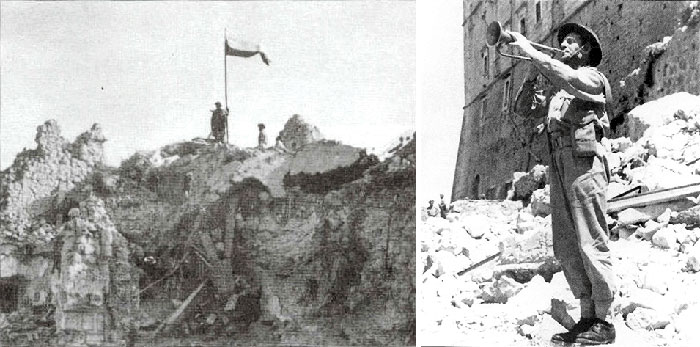
A Polish flag flies victorious in the captured fortress of Monte Cassino;
May 18, 1944: A Polish bugler announces the victory of Monte Cassino from amidst the ruins.
In May 1944 and after several attempts by British Commonwealth, US and French troops failed, the Polish II Corps captured Monte Cassino and opened the way to Rome.
Nearing the War’s End: The Warsaw Uprising and Beyond
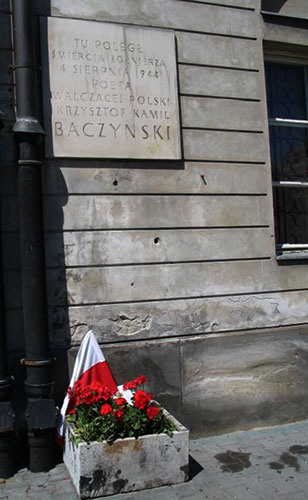
PHOTO: A tablet marks the spot in Warsaw where Baczyński fell during the 1944 Warsaw Uprising.
The words reads, “Here fell a soldier’s death August 4, 1944 the poet of fighting Poland, Krzysztof Kamil Baczyński.”
On August 1, 1944, Poland’s Home Army rose against the German occupation forces. The valor and the tragedy, as well as the hopes and ideals of a young generation, are exemplified by Krzysztof Kamil Baczyński, poet laureate of the Warsaw Uprising who was killed on the fourth day of the Uprising. He was 23.

LEFT: Soldiers from “Wacek” Platoon in “Zośka” Battalion with a German Panther tank they captured from Warsaw’s occupants.
RIGHT: Early morning on Sept. 2, 1944, soldiers from “Maciek” Company in “Zośka” Battalion; they’ve just escaped from one section of Warsaw to another via the underground sewer system.
The Zośka Battalion, which fought in the Warsaw Uprising, comprised very young fighters; many were Scouts before the war.
On the Uprising’s fifth day, Zośka captured a German tank. Their first action: Liberating Jewish prisoners in the heavily fortified Gęsiówka Prison Camp in the middle of the ghetto.
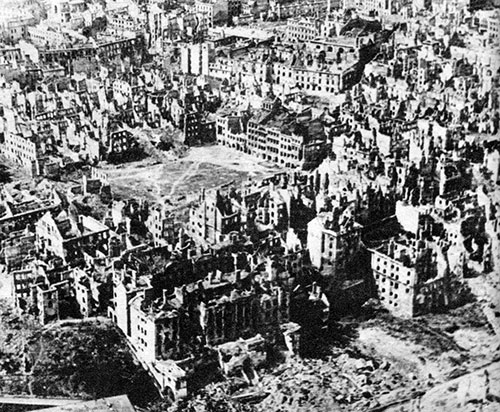
PHOTO: Warsaw destroyed; January 1945.
The aftermath: The surviving population was expelled; the remaining ruins after the Uprising were systematically razed.
The Red Army camped out on the other side of the Vistula River till the destruction was complete.
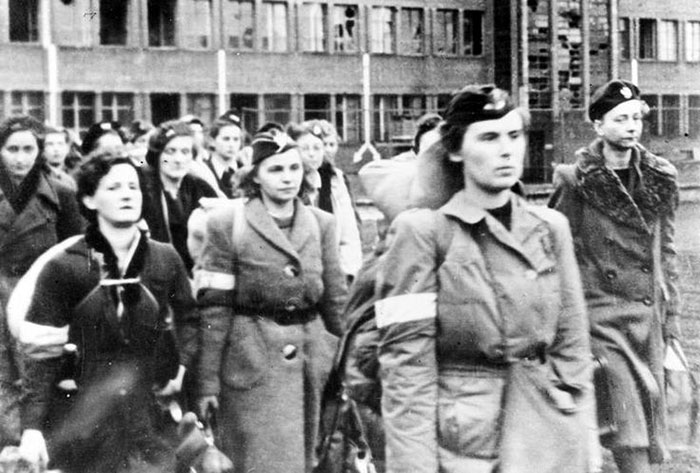
Polish POWs wear their red-and-white Uprising armbands in Oberlangen; 1944.
The women who fought in the Warsaw Uprising were sent to Stalag VI-C Oberlangen, the only POW camp in German-occupied Europe for women.
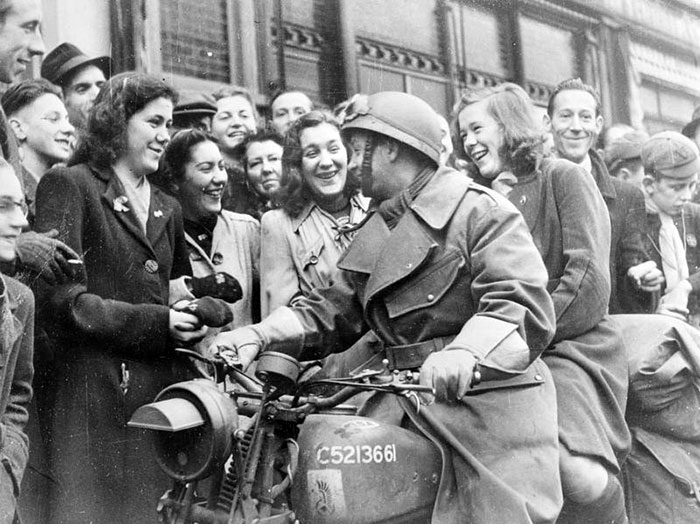
PHOTO: Breda residents greet Polish soldiers; the Polish Army freed the Dutch city from its German occupants on Oct. 30, 1944.
And while Warsaw burned the Polish First Armored Division was liberating France, Belgium and the Netherlands.
1945 – 1989

Warsaw; 1945.
The photo was printed from a Polish Archive negative in the 1960s.
Collection of Marek Tuszyński.
In 1945, the people of Warsaw began rebuilding their beloved city.

Witold Pilecki’s show trial in Warsaw.
This photo originally appeared in “Głos Ludu” (“Voice of the People”) in March 1948.
The communist regime, meanwhile, relentlessly persecuted members of the Resistance.
The only person to volunteer for Auschwitz, Polish officer Witold Pilecki spent nearly three years there, gathering and sending out intelligence reports, and forming a resistance group within. He escaped and fought in the Warsaw Uprising. Captured by communist authorities after the war, he was executed in 1948.
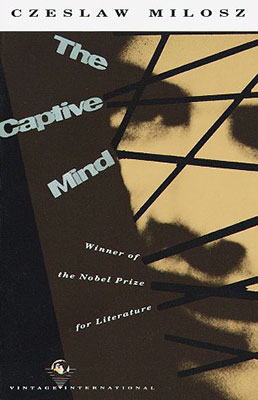
Czesław Miłosz defected from communist Poland in 1951. His non-fiction work The Captive Mind, published in 1953, is an indictment of the control over every aspect of life in the communist system.
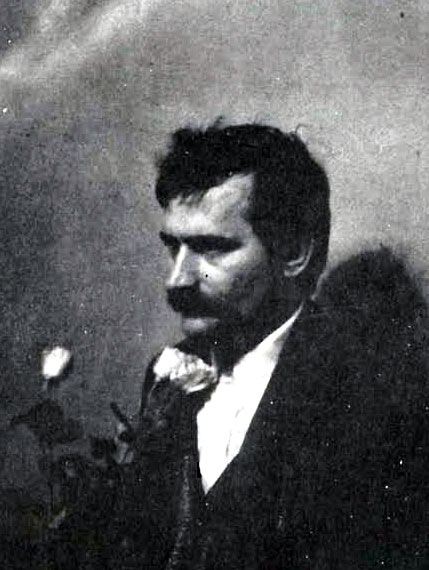
This photo of Lech Wałęsa appeard in the August-September 1980 issue of “Znak” (“Mark”).
In the 1970s, the failing economy triggered the quintessentially Polish Solidarity movement: united, inclusive, non-violent and democratic.
And there’s that mustache again! Lech Wałęsa, an electrician in the Gdańsk Shipyard, rose to become Solidarity’s leader.
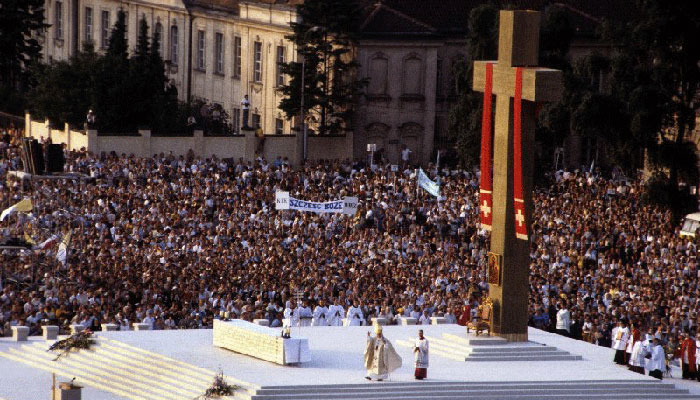
1979: The first visit of Karol Wojtyła as Pope attracted millions of Poles. The Communist Party ordered Polish TV to only show small groups of people to avoid showing the huge popular attraction of the Pope.
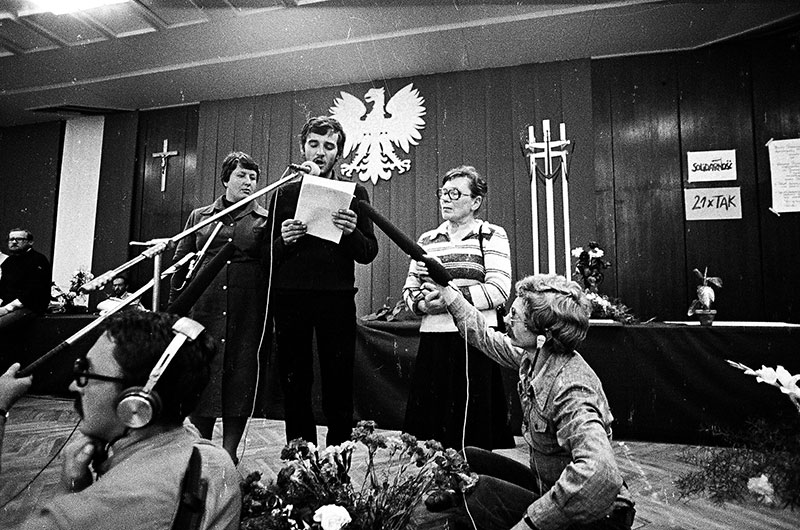
Andrzej Kołodziej at the mic; Anna Walentynowicz stands to his left.
Lenin Shipyard in Gdańsk; Aug. 20, 1980
Solidarity, a trade union with 10 million members, included the entire spectrum of society: workers, students, professionals, artists, writers.
In addition to Wałęsa, the leaders included Anna Walentynowicz. Her August 1980 firing from the Gdańsk Shipyard set off waves of strikes in Poland, paralyzing the Baltic coast.
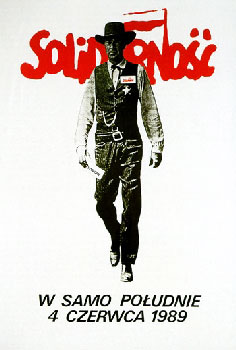
Graphic designer Tomasz Sarnecki transformed the Polish version of High Noon’s movie poster into a Solidarity election poster. Gary Cooper strides forward holding a folded election ballot; the Solidarity logo is pinned to his vest.
The words announce: “HIGH NOON JUNE 4, 1989”
1989: Campaign poster for the first free elections in a formerly Soviet-controlled country.
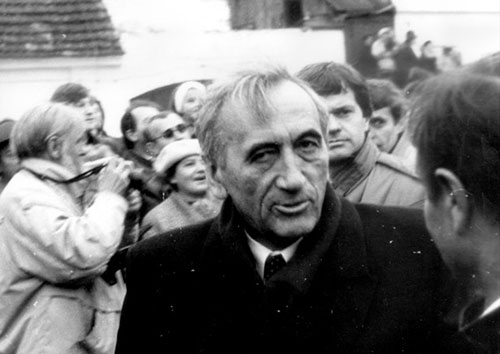
Tadeusz Mazowiecki in Poland; November 1989.
And the winner is: Tadeusz Mazowiecki, the first non-Communist Prime Minister of Poland since World War II.
1989 and beyond
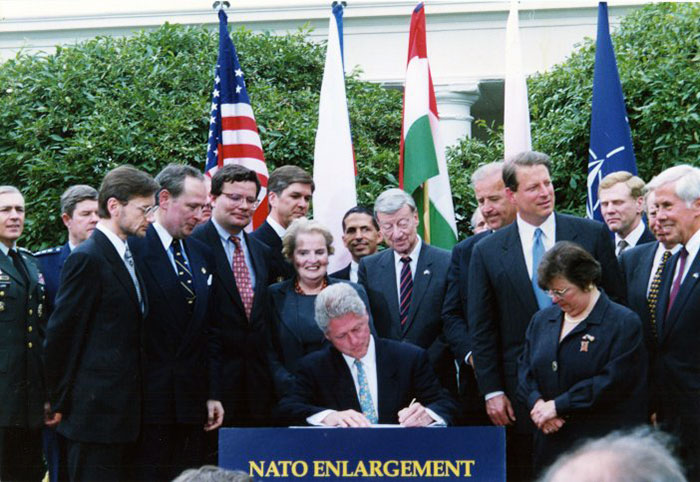
Poland’s Ambassador Jerzy Koźmiński and Secretary of State Madeleine Albright stand to the president’s right; on his left is Maryland Senator Barbara Mikulski of Maryland.
White House; May 21, 1998
On March 12, 1999, Poland entered NATO.
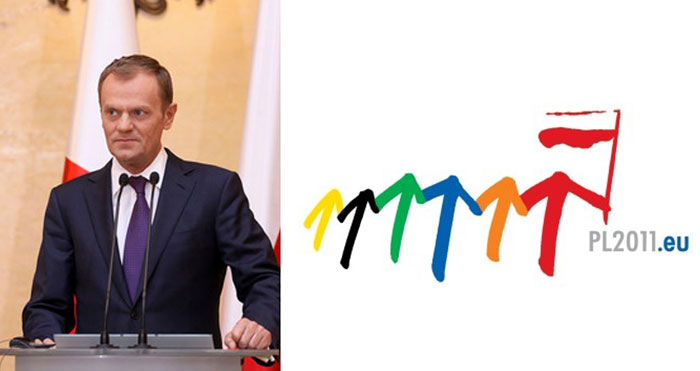
Donald Tusk in April 2011, and the logo of Poland’s EU presidency.
In 2004 Poland entered the EU, which graciously gave Poland a 10th anniversary present: the Presidency.
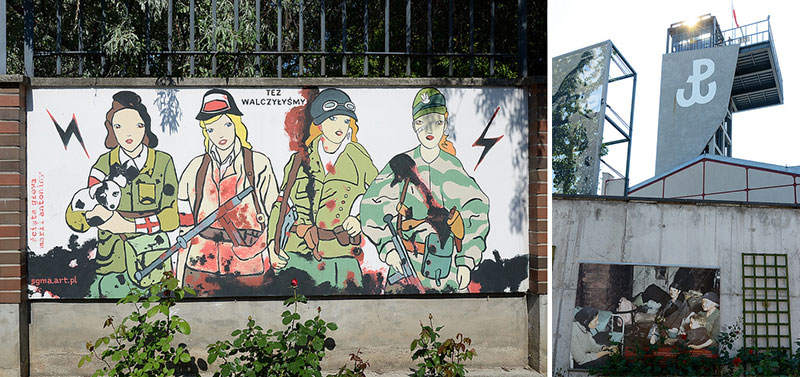
“Też walczyłyśmy” (“We also fought”) proclaims a mural depicting female Resistance fighters in the Museum’s garden. The museum’s exterior features a combined P and W, the sign of Poland’s Resistance, the largest such organization in war-torn Europe.
Photos: Justine Jablonska
Also in 2004: the Warsaw Uprising Museum was inaugurated – marking the Uprising’s 60th anniversary.
No memorial or commemoration was permitted under the communist regime.
2014: A year of anniversaries

2014 marks the 750th anniversary of the Statute of Kalisz, or the General Charter of Jewish Liberties. Artur Szyk’s beautifully rendered manuscript commemorates the 1264 statute, which detailed the rights and privileges granted to Poland’s Jews by Grand Duke Bolesław the Pious.
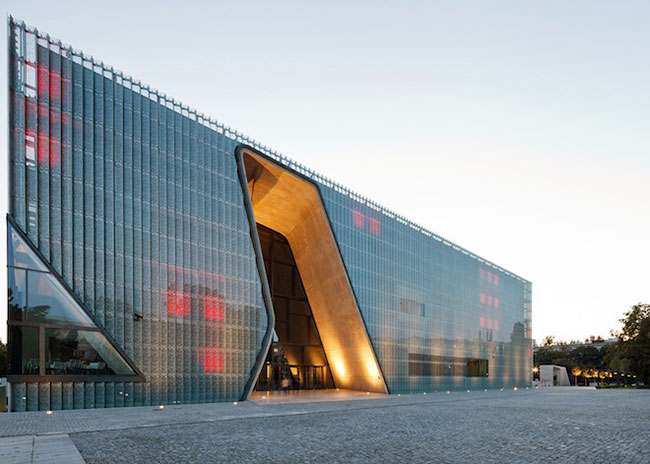
The museum’s exterior. It stands on the site of the wartime Warsaw Ghetto.
The 750th anniversary of the Statute of Kalisz is a wonderful symbolic year for the opening of the stunning new Polin Museum of the History of Polish Jews. The museum spans 1,000 years of Jewish history in Poland.

On the occasion of the 70th anniversary of the Warsaw Uprising, the presidents of Poland and Germany – Bronisław Komorowski and Joachim Gauck – opened the exhibition “Warsaw Rising” in the Topography of Terror Documentation Centre in Berlin, the site of the former headquarters of the SS, the Gestapo, and offices of Himmler and Göring.
In his address at the opening ceremony, President Gauck said, “Germans showed remorse and the Polish were able to forgive.”

Irmgard Sinner with Krystyna Wituska’s monument in the background at the dedication ceremony in Germany this spring.
Earlier this year, Germany honored Krystyna Wituska, a young member of the Home Army executed at the Institut für Anatomie gedenkt Opfer der NS-Zeit in Hall/Saale, Germany in 1944.
Irmgard Sinner initiated this project; she is the daughter of the officer, Werner Lueben, who sentenced Wituska to death.
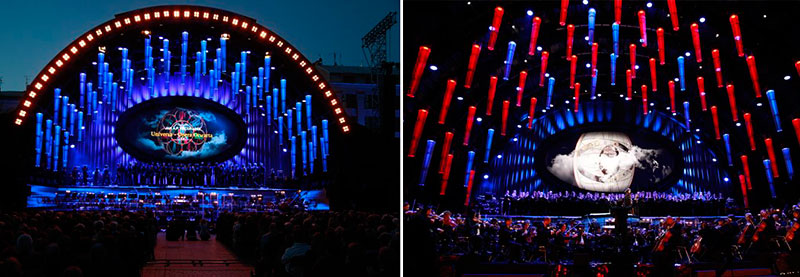
Photos courtesy of Uniwersytet Jagielloński
This year marks the 650th anniversary of Jagiellonian University, established by King Casimir III the Great in 1364.
Celebrated in grand style with a work by Jan A. P. Kaczmarek, “UNIVERSA Open Opera” that celebrates Queen Jadwiga, youthful exuberance, and an homage to the idea that reason always prevails over force.
A fitting end to Poland’s year of anniversaries.
CR
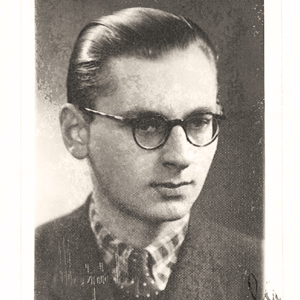



Pingback: Welcome to our 2014 Fall-Winter Issue!
Beautifully Done
Friday the movie The Imitation Games features the life and role of Turing in the Enigma phenomenon. Let’s see if there is any mention of the role of the Poles.
Congratulations to both, Justine Jablonska and Irene Tomaszewski, for a most captivating overview of memorable Polish historical moments. And thank you for including an art piece by Arthur Szyk. He entered my intellectual landscape for the first time this past June at the PIASA conference at the University of Warsaw. AG
Good job!
A beautifully done review, fitting so many essentials into just brief minutes ! An achievement for which I thank you. I’m amazed at how you captured the spirit of these events — many of which, from the 1930s on, were part of my life, so still feel very resonant. Am happy to see that their significance stands across generations.
Very well done and a excellent memorial to the many Poles who died fighting for freedom, usually without any real appreciation from the ‘others’
Pingback: Fall-Winter Version of the Cosmopolitan Evaluate | Posts
Great photos and captions! My father, Jerzy Kajetanski was in the AK and designed political cartoons for the underground press. He was a graduate student at the Academy of Fine Arts in Warsaw when WWII broke out. He painted many scenes from the war. Some are at the U.S. Holocaust Memorial Museum in Washington, D.C., others at the Museum of the Nicholas Copernicus University in Torun. Copies of his cartoons are at the Warsaw Museum of Political Cartoons.